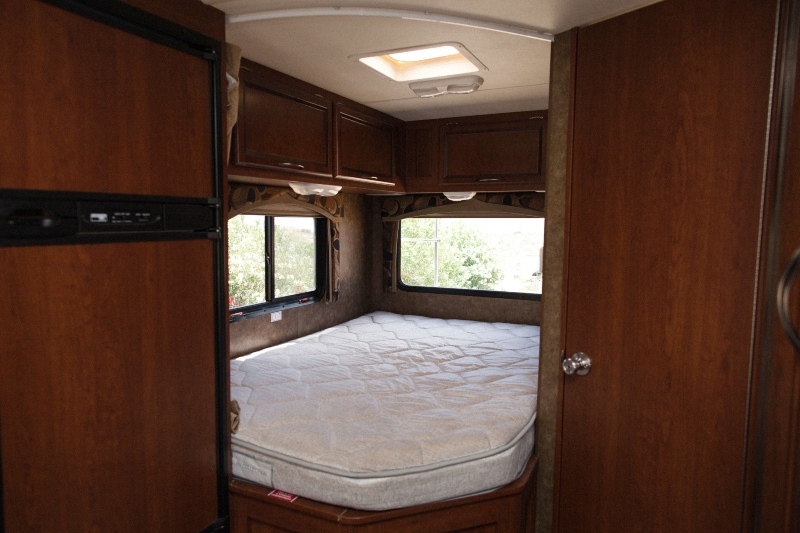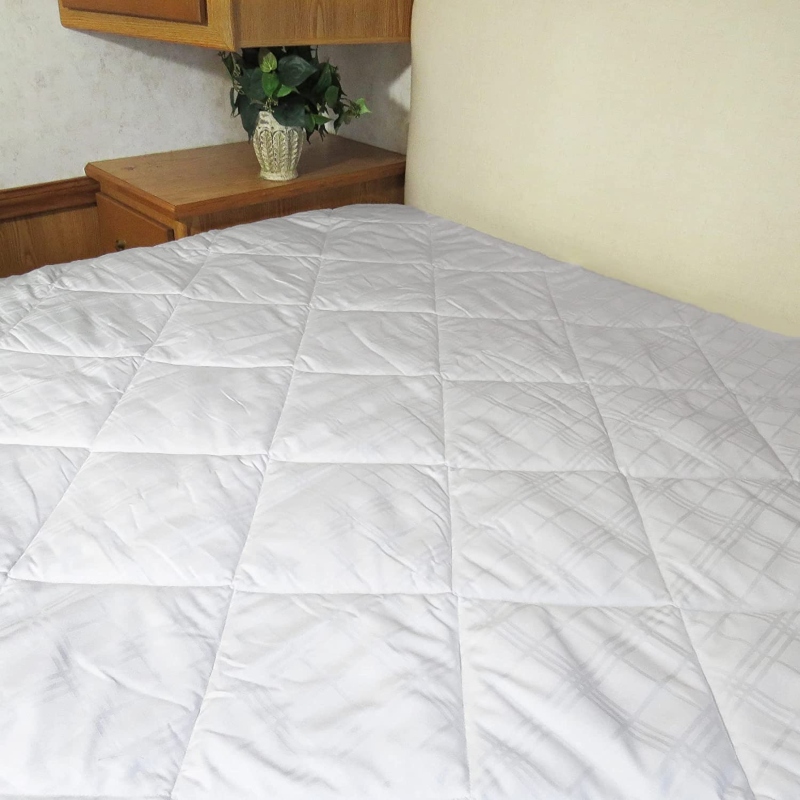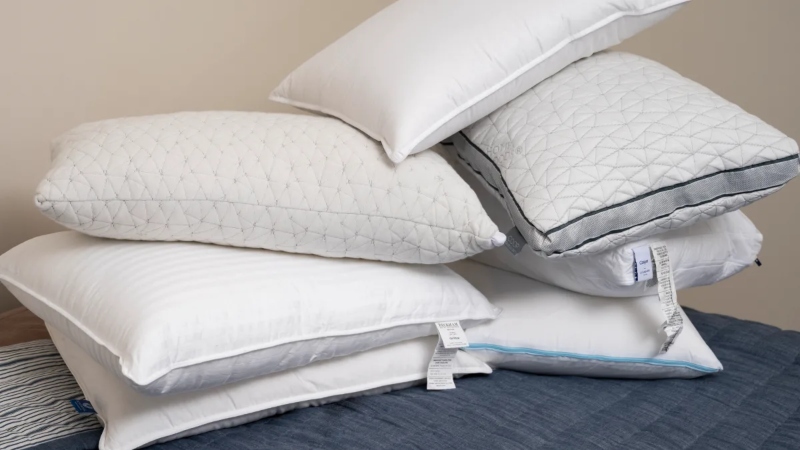Thanks for your support! If you make a purchase using our links in this article, we may make a commission. And, as an Amazon Associate, I earn from qualifying purchases. See the full disclosure here.
Updated April 18, 2024
If you’ve watched one of our many walkthroughs, you know that RV bedding is more complex than what you have in your home. You won’t find RV bedding linens at your favorite retail store. So, to do it right the first time, we’ve created this RV bedding guide to walk you through the process.
Our RV bedding guide will walk you through RV mattresses, helpful accessories, linens, and everything else. In addition, we’ve included the RV bedding information for the kids’ bunks and guest sleeping spaces. After all, you need a night of restful sleep to fully enjoy your RV adventures.
- Do RVs Come With Bedding?
- 4 Differences Between RV Bedding and Residential Beds
- Understanding RV Bedding Mattress Sizes
- What's the Best RV Mattress?
- 6 Ways to Sleep Better With RV Bedding Pads, Toppers, Insulators, and Pillows
- What and Where Can I Buy RV Sheets and Linens?
- Should You Remove RV Bedding In The Off-Season?
- How To Prevent RV Mattresses From Getting Mold
- Final Words About RV Bedding
- Related Reading:
- Mike Scarpignato – Bio
Do RVs Come With Bedding?
Oftentimes, an RV will come with a mattress in the primary bed but may lack mattresses throughout the rest of the RV. It really just depends. Some will come with some cheap pillows and some will come with thin mattresses that really aren’t that comfortable to begin with.
In most cases, unless you purchase a tiny, one-bed camper that comes with a mattress, you will have to purchase some level of bedding for your RV, especially for beds other than the master bed.
You’ll also have to get used to the sizes, as RV bed measurements are not always the same as residential bed mattresses.
4 Differences Between RV Bedding and Residential Beds

1. It’s a Hard Knock Life for RV Bedding
No matter how well-built your motorhome or travel trailer is, your RV bedding will be exposed to temperature change, moisture, travel conditions, and other conditions. Your bricks-and-sticks residential bed lives in a more stable environment, so it lasts longer.
Generally, the average lifespan of an RV mattress is 8 years. However, full-timers may want to change their out after every U.S. Presidential election.
2. “Placeholder” RV Mattresses

Unless your RV comes with a top-quality mattress, many RV manufacturers have changed their perspective on their provided RV bedding. They’re good enough to sleep on, but in the Modern Era (2008-Present), RV companies use “placeholder” mattresses.
With so many mattress companies now offering RV mattress sizes, linens, and accessories, RVers are replacing the original RV mattress with an aftermarket RV mattress that fits their comfort level.
3. RV Beds Lay on Wood

Your residential bed can have a box spring, spring-like slats, and other support innovations beneath the mattress. Under your RV mattress is a version of plywood; that’s it. There are various pads, pillows, and other accessories if you need additional support for your spine or joints.
4. RV Bedding Has Many Sizes

Some RV mattresses come in residential sizes. In those situations, you can go to your favorite retail store and pick up RV bedding in every color, material, and pattern. But as you’ll see, when you try fitting a set of queen sheets on an RV short queen bed, it won’t fit correctly.
Understanding RV Bedding Mattress Sizes

Residential mattresses typically come in 6 sizes:
- Twin
- Twin XL
- Full
- Queen
- King
- California King
RV bedding and mattresses have many more sizes. Designers have to make every square inch count. If they can shave off an inch on a bed to make a slide box fit better and increase the walkway, they’ll do it if needed.
This type of decision-making has occurred since 1910. Yet, the Modern Era is the most excellent time to find RV bedding. Today, you’ll find the most aftermarket RV mattresses, linens, and accessories made in RV dimensions.
To help you understand the different RV mattress sizes, here’s a chart of the typical sizes and where you’ll usually see them. Those in bold are residential mattress measurements.
RV Mattress Size Chart
| RV Mattress Sizes | Dimensions (W x L, inches) | Description |
|---|---|---|
| Bunk/ Twin | 28 x 75 30 x 75 30 x 80 34 x 75 35 x 79 38 x 75 38 x 80 | Twin and Twin XL-sized beds come in a variety of sizes. You’ll see them in bunk beds or convertible furniture. |
| Three Quarter | 48 x 75 48 x 80 (XL) | A 3/4 RV mattress is narrower but sometimes longer than a full-size mattress. Jackknife sofas and convertible furniture favor these dimensions. |
| Full | 53 x 75 54 x 75 55 x 75 | The word “Double” and “Full” get fuzzy in the RV industry. They can measure equally or be an inch or 2 off. You’ll find full-size beds in bunks, small travel trailers, campers, and convertible furniture. |
| RV Short Queen | 60 x 74 60 x 75 | The RV Short Queen existed before the slide-out. Today, you’ll find these mattresses in most towables and drivables. |
| Queen | 60 x 80 | Residential queens are replacing their shorter sisters as slide-out innovation evolves. They’re in plenty of mid-size and larger towable or drivable RVs. |
| Short King | 72 x 75 | The RV short king is another designer compromise mattress. They’re popular in larger towable, Class A motorhomes, and some camper vans. |
| RV King | 72 x 80 | RV kings have the length but are missing 4-inches from the width. The spacing allows for slide boxes or nightstands. Luxury pop-up camper may have an RV king. |
| Eastern King | 76 x 80 | Eastern kings are also known as residential king beds. |
| California King | 72 x 84 | The California king, or western king, is also a residential size. You’ll find these mattresses in luxury-level RVs. However, notice it’s 4-inches narrower. |
If you have a corner-cut mattress in your Class C motorhome, these mattresses come in either a three-quarter, RV short queen or RV king. If it’s a king, the length may measure 75 inches instead of the full 80 inches.
What’s the Best RV Mattress?
The best RV mattress is the one that feels right for you. When the inflatable air mattresses first came out, they were the “Belle of the Ball” in the RV industry. Today, memory foam, latex, and innerspring/memory foam hybrids are the “soup of the day.”
We always recommend trying a few brands out at a home furniture store, even if you’re going to order your RV bedding online. Every RV mattress brand has a different definition of firm, medium, and soft. So you’ll want the best idea of what those terms mean.
Online mattress companies have trial periods, but their return policies can be complicated. Ensure you learn everything you can about the best RV mattress brands, including their return policies.
6 Ways to Sleep Better With RV Bedding Pads, Toppers, Insulators, and Pillows

The next section of our RV Bedding Guide is the accessories. Again, some may feel that they’re not needed, but we’ve already shown you that your RV mattress has a more challenging life than your bricks-and-sticks home bed.
Small and mid-size travel trailers with front bedrooms offer the convenience of accessing the storage bay when you lift the bed platform up. The problem with that is your exterior bay’s weatherstripping isn’t perfect. In extreme temperatures, you could feel like you’re sleeping on an icebox or furnace. There are moisture considerations to keep in mind too.
Here are some RV bedding accessories that can further protect your mattress and linens giving you a better night’s rest.
1. RV Mattress Pads

Mattress pads are great for all types of mattresses. Besides protecting them from spills and holding your sheets better, they protect your RV’s bed from moisture. Water is fine for sinks and bathrooms, but you don’t want it building up on your mattress. It quickens memory foam elasticity loss and rusts innerspring.
If you’re sensitive to allergens, mattress pads prevent them from getting into your mattress. Thicker versions even add a layer of comfort. The best part is that they’re machine washable. If you’re starting to take allergy medicine at night more often, wash your RV’s mattress pad. That may solve the problem.
2. RV Mattress Toppers

Buying a new RV mattress might not be in the cards right now. However, adding a bed topper as an extra layer can counter some of the thinning effects as your mattress becomes more worn. At one point, this author could feel the wood platform under the memory foam mattress on hot nights. An affordable topper saved his back.
RV mattress toppers also breathe. They can keep moisture and heat from building up, better protecting a mattress. In turn, this can elongate your mattress’s lifespan. Of course, spilling your morning coffee on the topper isn’t as bad as if it was on the bed.
3. RV Mattress Insulators

RV manufacturers like Lance, Alaskan Campers, and others include radiant sheets under their RV mattresses in all-season packages. To you, it may look like shipping bubble wrap with an aluminum foil coating. But, UV rays and heat energy “see” it as an insulating barrier.
If your RV season continues after September through March, you’ll want to have a roll of radiant sheeting like Reflectix or another version. Here are some other tips if you plan on cold-weather camping.
4. RV Mattress Moisture Barriers

On the opposite side, during the peak of the RV camping season, using an RV mattress moisture barrier between your bed platform and mattress will save you money. Protective layers like Tochta’s HyPur FLO Mattress Moisture Barrier keep the sweat and other moisture from ruining your RV bedding.
An RV mattress moisture barrier lets you keep your RV mattress longer, helps you use less energy for the air conditioner, and gives you a better night’s rest. Three fewer reasons to be nicknamed “Mr./Ms. Cranky Pants;” works for us!
5. Head and Joint Pillows


The best pillow in the right spot can distinguish between pleasant dreams and insomnia. For some, a simple head pillow works great. However, for that side, back, or front sleeper that wakes up sore, “there’s a pillow for that.”
Triangular wedges, contour head pillows, knee pillows, and others can keep your body aligned at night. Without his knee spacer pillow, this author won’t turn the ignition on his motorhome. It may be an RV bedding accessory, but he added it to his essential accessories list.
What and Where Can I Buy RV Sheets and Linens?

Not everyone will want to sleep in Camco’s Life is Better at the Campsite RV bedding sheet set, but they are available on Amazon and in camping stores. There are many styles, colors, and patterns for RV bedding sizes.
1. Types of RV Bedding Linen Materials
Like residential linens, you’ll find all of the same sheet materials. When choosing your linens, think about how often you’ll be using them, when you’ll be camping, and who’s using them. Are you allergic to natural fibers? Is anyone rough on their sheets? Do you need a deep pocket sheet for a thicker mattress?
- Egyptian Cotton: Real Egyptian cotton is small in diameter but has extra-long fibers. It’s very smooth and soft. Look for Extra-Long Staple (ELS) on the packaging to know it’s real.
- Cotton: Cotton breaths and is very affordable. Higher thread counts aren’t necessarily better, especially if you’re replacing your RV bedding due to your pet’s claws creating holes.
- Flannel: Flannel is made from cotton, but it retains heat. Keep them in your storage bays for cooler nights.
- Satin/Silk: Satin and silk sheets are fragile and not recommended for the RV lifestyle. They are hypoallergenic and usually have special washing instructions. Leave them at home unless you need them for medical reasons or special occasions.
- Microfiber: Microfibers are synthetic and wrinkle-free. Flatweave versions trap heat and absorb moisture which can be an asset to protect your mattress.
- Polyester: Polyester is a highly durable petroleum plastic. It’s great for the kids and for convertible dinettes and sofas. If the sheets catch on the furniture’s mechanics, it’s the least likely to tear.
2. Zipper-Style RV Bedding
In our Gulfstream Conquest YouTube Tour, you learn that Mike was the one who changed the RV bedding linens because it’s challenging to do. It was one of the factors that we added to our list when deciding if we should renovate or buy something new. Check our YouTube Channel to learn how we solved this dilemma.

If you have this same problem or want an easier way to keep your RV bed linens in place, you may want to look into zipper sheets. Class C motorhomes with corner beds can be tricky since there’s virtually no corner access. Brands like QuickZip have all of the fashionable colors and styles.
Zipper sheets encompass the entire mattress and zip around the perimeter. That way, you can retire your contortion RV bedding performance.
3. Blankets & Comforters

To top off your RV bedding, you want blankets and comforters that store well. The problem with comforters is that they take up a lot of storage space. The best way to store comforters when you’re not using them is to keep them in zip-top vacuum bags with other RV winter gear.
Summer weave blankets are light for the RV camping season, expel just enough heat to keep you comfortable, and take up very little storage space. In addition, these blankets are very budget-friendly and come in almost every color imaginable.
The very best comforter we found works great in summer and winter. We don’t know why but this comforter from Lakeside Collection keeps us cool in summer and warm in winter! We highly recommend it!
If you need something heavier, fleece blankets are surprisingly warm. Much like the weave blankets, they’re easy on the wallet, store well, and fit any decor.
Should You Remove RV Bedding In The Off-Season?
Yes, you should remove all RV bedding prior to the off-season. As a matter of fact, you should take things a step further and also remove anything that’s cloth, including curtains, throws, blankets on the couch, pillowcases on couch cushions, etc.
The cloth fabrics within your RV hold in whatever odors or scents are in the RV while it is in use. These lingering scents will, like water, sort of stagnate, creating a musky odor that’s often difficult to get rid of in the short term.
This also includes towels and rags you use as washcloths. Some RVers prefer to leave all of these things inside the RV, choosing to do a mass-spring cleaning when the time comes, running everything through the wash and drying it. However, if there is a musky odor left behind, it will take time to air it out.
How To Prevent RV Mattresses From Getting Mold
Though mold can form on the top surface of an RV mattress, it’s far more likely it will form on the bottom. Mold requires warmth and moisture to grow and spread. If you’re storing your RV in a humid environment, such as Florida or a state close to the water, moisture in the air is a given.
One of the first things you need to do, prior to storage, is flip the mattress over and use a box fan to blow on it for a while, drying out the surface. Make sure the mattress never ends up on the floor. It’s also a good idea to bring in a dehumidifier and let it run for a while.
Make your way through your RV and locate any sources of excess moisture. Clean and dry anything you find to reduce evaporation and moisture in the air. Throughout the months when you are using your RV, rotate the mattress occasionally, and place a waterproof mattress cover over it after drying.
Final Words About RV Bedding

Our RV Bedding Guide has taken you through the components that make up the best RV bedding. Mixing and matching the proper layers together is the key to the ultimate RV bed. Use your home bed ideas as inspiration to design your RV bedding concepts.
If you need RV bedding that will minimize spine and joint issues, please speak to your professional if you need RV bedding to reduce spine and joint issues medical team. They know the best pillows and devices to help you best.
Remember, you spend a third of your life in bed. So make your RV vacation sleeping experience as remarkable as your RV adventures.
Related Reading:
– Can You Sleep in an RV While Driving?
– Best RV Mattress Toppers – Reviewed and Rated
– 9 Best RV Short Queen Mattresses
– 19 Best Decorating Ideas For Travel Trailers or RVs
Mike Scarpignato – Bio
Mike Scarpignato created RVBlogger.com over five years ago in 2018 to share all we have learned about RV camping.
Mike is an avid outdoorsman with decades of experience tent camping and traveling in his 2008 Gulf Stream Conquest Class C RV and 2021 Thor Challenger Class A motorhome.
We attend RV Shows and visit RV dealerships all across the country to tour and review drivable motorhomes and towable trailers to provide the best evaluations of these RVs in our blog articles and YouTube videos.
We are 3/4-time RVers who created RVBlogger.com to provide helpful information about all kinds of RVs and related products, gear, camping memberships, tips, hacks and advice.


